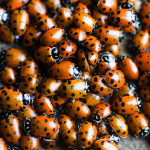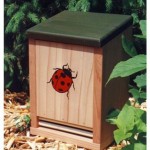Ladybug! Ladybug! Fly away home.
By Paul Stein
 One of the most important insects to gardeners throughout Calaveras County is the colorful ladybug. Not only does this classy beetle brighten the garden with its familiar red-orange cape dotted with black polka dots, but it can eat its weight in aphids in a single day! This talent alone makes them a champion to green-thumbs across the land. The ladybug’s sole mission is nothing short of an all-out blitzkrieg against the scourge of rose enthusiasts and flower growers everywhere. Just ask anyone familiar with roses to describe their favorite insect and nine times out of ten it will be the flamboyant ladybug.
One of the most important insects to gardeners throughout Calaveras County is the colorful ladybug. Not only does this classy beetle brighten the garden with its familiar red-orange cape dotted with black polka dots, but it can eat its weight in aphids in a single day! This talent alone makes them a champion to green-thumbs across the land. The ladybug’s sole mission is nothing short of an all-out blitzkrieg against the scourge of rose enthusiasts and flower growers everywhere. Just ask anyone familiar with roses to describe their favorite insect and nine times out of ten it will be the flamboyant ladybug.
To entomologists—scientists who specialize in the study of insects—ladybugs are actually classified as beetles from the order Coleoptera. Europeans have called these dome-backed beetles by the name ladybirds, or ladybird beetles, for over 500 years. In America, the name ladybird was replaced by ladybug but scientists usually prefer the common name lady beetle to distinguish them from true bugs.
Legend ties this brilliantly colored orange-red insect to the Virgin Mary. During the Middle Ages farmers in Europe began praying to the Virgin Mary, or Blessed Lady, to rid a plague destroying their corps. Not long after the orange beetles began showing up in the fields and the crops were miraculously saved from the infestation. The ladybug was considered the reason, so they became known as Lady Beetles. In Germany, these insects go by the name Marienkafer, which means Mary beetles. The 7-spotted lady beetle is believed to be the first named for the Virgin Mary; the red color represents her cloak, and the black spots represent her sorrows.
A ladybug’s bright colors are a common warning to predators to be wary. Similar to many poisonous species—notably mushrooms, fish, and a variety of plants—the ladybug’s vibrant coloration signals their toxicity to would-be predators. Ladybugs excrete a poison from their legs and abdomens. Insect-eating birds and other animals learn to avoid meals that come in red and black, and are likely to pass up a ladybug lunch.
Gardeners welcome ladybugs with open arms. Ladybugs feed on soft-bodied insects including scale insects, white flies, mites, and some spiders. A hungry ladybug adult can devour 50 aphids per day and may consume as many as 5,000 aphids over its lifetime, making it one of the best biological control agents available to gardeners. Biological control is an environmentally sound and effective means of reducing or mitigating pests and pest effects through the use of natural enemies.
Ladybugs hibernate in the fall, gathering in large aggregations in protected places. As days get shorter and temperatures fall, ladybugs seek shelter behind bark, under leaves, in weeds or in other protected locations, such as in light colored houses which reflect heat. Thousands of ladybugs may gather in the same location, taking advantage of the collective warmth of a colony. Convergent ladybugs gather in the mountains in such numbers that collectors can scoop them up by the bucket. It’s not uncommon to find mounds of thousands of ladybugs as they enter the hibernation phase to winter-over. When the weather warms they will emerge and swarm, much like a beehive swarms in early spring to establish a new hive.
A common misperception is that a ladybug’s age can be determined by the number of dots on its shell. In truth, the spots on a ladybug’s back have nothing whatsoever to do with its age, fun as it may be to count them. In some cases, though, you can determine the species by taking note of the number and position of its markings. The seven-spotted lady beetle, for example, has seven black spots on its red back.
Many gardeners put out ladybug boxes to attract ladybugs to hibernate close to their garden. These nests are typically made from a 7” x 10” pine box with a small slit at the bottom to allow the insects to enter. Organic matter such as leaf mulch is added to the box, along with ladybug lure (made from aphid scent). The classy little insects find the nest and do the rest. Then just wait for spring and these aphid-eating machines will be hard at work in the garden. There are even ladybug wholesalers who specialize in raising ladybugs that can ship you these garden enforcers if there aren’t enough naturally found in your garden.
typically made from a 7” x 10” pine box with a small slit at the bottom to allow the insects to enter. Organic matter such as leaf mulch is added to the box, along with ladybug lure (made from aphid scent). The classy little insects find the nest and do the rest. Then just wait for spring and these aphid-eating machines will be hard at work in the garden. There are even ladybug wholesalers who specialize in raising ladybugs that can ship you these garden enforcers if there aren’t enough naturally found in your garden.
Delight in the arrival of spring and look closely for the emergence of colorful ladybugs to police your garden from even the most persistent insect pests!
Paul Stein is a biologist with a long career in aquaculture. He was formerly Chief Deputy Director of the California Department of Fish & Wildlife. He can be reached at [email protected]
Ladybug houses and lure can be purchased through:
Willow Tree Farms 128 Spring Meadows Lane
Statesville NC 28677
1-877-794-5569
Wholesale live ladybugs can be purchased through:
GardeningZone.com
PO Box 3385
Camarillo, California 93011
Toll Free: 1-800-493-1885
Customer Service: [email protected]



